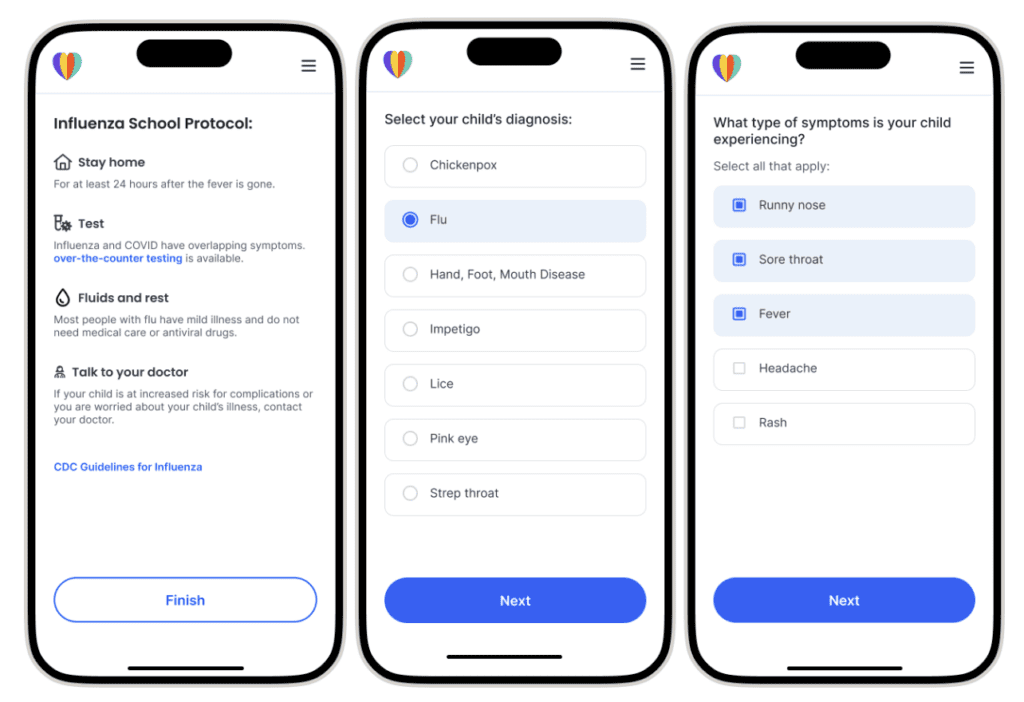
Comprehensive screening can help schools reduce the impact of respiratory disease on students and staff.
Did you know one of the most effective interventions for stopping the spread of respiratory diseases during the pandemic was screening symptomatic infectious individuals with rapid tests before entering school?
By identifying infected individuals, such as adult superspreaders, and asking them to stay home, we reduce disease transmission and give passive interventions such as improved air purification a chance to keep up in our classrooms.
Today, there are over-the-counter (OTC) test kits available that can test for both Flu and COVID-19. Additionally, schools can obtain a CLIA Waiver, a license from the state, to administer the same tests doctors run in their offices. These tests can detect a wide range of pathogens, including RSV and Streptococcus.
Finally, schools in affected areas can monitor the spread of Highly Pathogenic Avian Influenza (HPAI), also known as H5N1 and bird flu, and coordinate testing with public health authorities if needed.
Respiratory disease and absenteeism
Acute respiratory illnesses (ARIs) are common in school-aged children and can cause significant absenteeism. For example, a 2017 study found that 1,027 children enrolled in an influenza vaccine effectiveness study missed 2,295 days of school due to ARIs, with influenza accounting for 47 percent of those days.
And in 2022, a ‘tripledemic‘ of respiratory illnesses — Flu, RSV, and COVID-19 — forced schools in several states to close temporarily due to high rates of absenteeism.
Fortunately, respiratory disease testing is one way for schools to reduce cases among staff and students, foster a safe and healthy learning environment, and remain open during peak respiratory season.
Streamline school testing
Using lessons learned from the pandemic, it’s easier than ever to implement respiratory disease testing in schools. This five-step workflow outlines diagnostic testing in support of the Centers for Disease Control and Prevention (CDC) current guidance for schools:
- Communicate with parents when community levels for Flu and COVID-19 are high, using local wastewater or hospital data, and ask them to keep an unexpired OTC rapid test on hand. Parents should use rapid testing to self-diagnose Flu and COVID-19 when children are at home and symptomatic.
- Communicate to staff and local childcare providers when community levels for Flu and COVID-19 are high, and ask them to keep OTC rapid tests on hand. Staff should use rapid testing to self-diagnose Flu and COVID-19 when at home and symptomatic.
- Use the rapid test results as evidence for excused absences and to help parents or staff secure PTO use from their employer. If no rapid test is available, ask them to log the fever temperature, take a thermometer photo, and provide parental attestation of the symptoms.
- Follow the CDC and state guidance on staying home and when to return to school.
- If parents and staff are uncertain about being mildly symptomatic and improving but fear they might still be highly infectious, advise them to use a rapid lateral flow test. A positive result indicates the person can still be infectious.

Using rapid tests under the CDC’s new guidance will reduce the reproductive rate of viral respiratory infections in your student population. This reduction can help to decrease student and teacher absenteeism. And while some individuals may experience slightly extended absences, the overall result will be a healthier and happier campus.
Plan now for fall respiratory season
To get ready for the annual wave of respiratory illness, consider securing rapid OTC tests for COVID-19 and Flu from your local public health or educational authority. Consider bulk purchasing tests to send home on back-to-school night.
Additionally, securing a CLIA Waiver for your school staff will support teachers and students with onsite testing when access to a provider may be difficult or disruptive to school operations. Prompt testing can reduce disease spread and will provide the school with data and tools to manage the respiratory season effectively.
How Primary.Health can help
Our school health management software streamlines test administration tasks, integrating seamlessly with the student information system and staff, parent, and student devices. This automation eliminates the need for paperwork, emails, and voicemails related to parental communications and data. Crucially, school leaders will have structured data on incidents, causes, and impacts, enabling informed decisions during the peak respiratory virus season.
We can also help you secure a CLIA Waiver to conduct onsite testing, procure test kits if needed, and provide virtual follow-up care.
One of the positive outcomes of the pandemic was the recognition and understanding that we can effectively control the spread of diseases. Let’s do it together.
